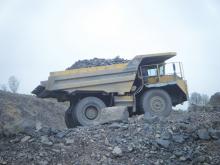The shot rock (similar to granite and good for coarse road base) used to be loaded into
As the quarry has exhausted its pit boundaries to the north and west, so expansion is moving to the south side of the pit and into lower levels of rock reserves. The quarry firm explained that as the pit deepened its haul roads grew longer and cycle times increased, which in turn slowed production. As a result, the firm looked at options that would allow it to go faster uphill, but then looked at the economic aspect of putting the primary crusher closer to the deposits and hauling rock downhill.
A major capital project started in spring 2017 to relocate the primary crusher nearly 116m below its original elevation and install conveyors to shuttle the crushed stone back uphill to the finishing plant. The production benefit is two-fold. Loaded haulers now travel downhill and can operate faster and use gravity to save on fuel consumption. If the crushing plant is the heart of a quarry, the first line excavator is the pulse, setting cycle times by how fast it can load trucks.
As part of the expansion project the quarry upgraded its primary excavator to a Volvo EC750E to meet the increased production from the crushing plant’s new workflow. The super-abrasive environment, running 12-hour shifts five days a week, demanded a durable and powerful excavator. The 75tonne class machine is powered by a 385kW Volvo Tier 4 final engine and is matched to a Rockland 5m3 bucket that has been modified internally and externally with guards over the cutting edge and side shrouds. The buckets are lined with AR450 or 500 plate and T1.
According to Savage Stone, the firm is getting 96 hours on a set of teeth, so it is averaging three teeth changes for every oil change.
Savage Stone assigns a cost value to every piece of equipment down to the minute. This formula was developed from crunching production sheets to calculate tonnage/day. Management uses this data when evaluating when to replace equipment and as comparisons in the purchase process. The firm added that it has a certain number of tonnes it has to meet every day to cover costs.
The company looked at a number of excavators from different firms but says it opted for the Volvo CE unit as it fared well in terms of productivity and reliability, as well as offering comparatively low running costs for fuel, oil and servicing.
Volvo CE machines boost output for US quarry
At Savage Stone’s 161.9ha quarry in Jessup, Maryland, gabbro is extracted from five 13.1m-tall benches, with chemical rock hardness increasing with each lower level.
The shot rock (similar to granite and good for coarse road base) used to be loaded into Volvo 31tonne and 36tonne capacity articulated haulers and 90tonne capacity Euclid rigid haulers and transported 800m uphill to the primary crusher, a Lippmann 5062 jaw crusher. The jaw crusher processes rock to 127-178mm, which is then stockpiled on the s
At Savage Stone’s 161.9ha quarry in Jessup, Maryland, gabbro is extracted from five 13.1m-tall benches, with chemical rock hardness increasing with each lower level.









